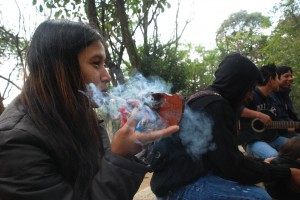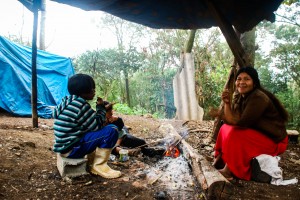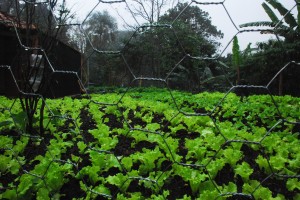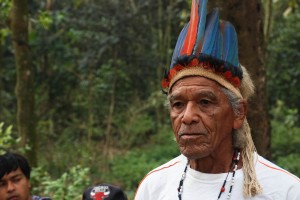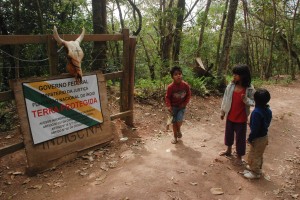 The regions in the south and southeast of Brazil are the richest areas in the country and the most industrialized in Latin America. The southeast alone is responsible for 60% of GDP, and thus, in this region 90% of the population is concentrated in urban zones. In this geography of modernity there is also an indigenous territory that is in its death throes, the land of the Guaraní. The population is concentrated principally on the shores of the Atlantic Ocean in the states of Rio Grande del Sur, Santa Catarina, Paraná, Sao Paolo, Rio de Janeiro, Espiritu Santo and Mato Grosso del Sul. They are the largest indigenous group in Brazil, estimated at around 50,000 people.
The regions in the south and southeast of Brazil are the richest areas in the country and the most industrialized in Latin America. The southeast alone is responsible for 60% of GDP, and thus, in this region 90% of the population is concentrated in urban zones. In this geography of modernity there is also an indigenous territory that is in its death throes, the land of the Guaraní. The population is concentrated principally on the shores of the Atlantic Ocean in the states of Rio Grande del Sur, Santa Catarina, Paraná, Sao Paolo, Rio de Janeiro, Espiritu Santo and Mato Grosso del Sul. They are the largest indigenous group in Brazil, estimated at around 50,000 people.
The Mata Atlantica, where the Guaraní are from originally, is the fundamental physical and cultural environment of the communities, and has been reduced to 22% of its original size, according to data from the Ministry of the Environment in 2011. Of this total, only 7% is well conserved. “Since the colonization of the country, the economic processes have been oriented toward the perspective of growth and development, and have been destroying the Mata Atlantica and corralling indigenous people,” states anthropologist María Inés Ladeira to the Americas Program. Ladeira works with the Center for Indigenous Labor, which for at least 3 decades has been documenting the experiences of the Guaraní. The image of the containment of the Guaraní can be visualized using general data from the regularized areas in Brazil. Of the regularized indigenous lands, in terms of land area, 98.75% is in the Amazon region. However, 554,081 of the 896,917 indigenous individuals in Brazil, according to the census from the Brazilian Institute of Geography and Statistics from 2010, live in other regions of the country, counting only 1.25% of the extension of regularized indigenous lands, according to the Report on Violence against indigenous people in Brazil, data from 2013, of the Indigenous Missionary Council. “It’s not that in the Amazon there is a lot of regularized territory, outside of these indigenous areas they are worse, because they are extremely small, because of which it is impossible that indigenous people can establish their living space and live with dignity,” states Ladeira.
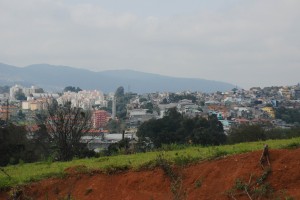 One form of violence, documented in the report, was the fact that the President of Brazil, Dilma Rousseff, stopped the processes for the demarcation of Indigenous lands. “The attitude of paralyzing the already delinquent processes demonstrate that the attention of the government is focused on the sectors of the economy and the politics connected with the large land holders, agribusiness, mining contractors and the hydraulic energy corporations, which have as their exclusive objective the exploration of natural resources in lands traditionally occupied by indigenous people,” states CIMI’s document.
One form of violence, documented in the report, was the fact that the President of Brazil, Dilma Rousseff, stopped the processes for the demarcation of Indigenous lands. “The attitude of paralyzing the already delinquent processes demonstrate that the attention of the government is focused on the sectors of the economy and the politics connected with the large land holders, agribusiness, mining contractors and the hydraulic energy corporations, which have as their exclusive objective the exploration of natural resources in lands traditionally occupied by indigenous people,” states CIMI’s document.
The demarcation of the lands has been one of the resources of the indigenous struggle in Brazil, but the delimiting of an area goes against the logic of the very conception of themselves as the Guaraní Nation, who don’tobserve the borders of nation-states in South America. “For the Guaraní, the demarcation means reducing their territory and their subsequent confinement to that area. However, they are conscious that, in the rest of the world, this is the only alternative,” sustains the anthropologist.
The Interamerican Development Bank has registered at least 50 million indigenous individuals in Latin America. Brazil continues to be the country with the greatest diversity in terms of indigenous languages; there are 204 groups and 180 languages that survive despite the fact that a great number of them were eliminated with the extermination of entire towns during the period of European colonization and during the dictatorship, followed by expansive, industrial agriculture, called the Green Revolution.
It is true that the life conditions of the Guaraní today are at a critical point. It is also true that their survival is not mere coincidence; in them reside the bonds of strength. Perhaps their principal strength comes from their identity and their integration, which extends to territories in Argentina, Paraguay, Uruguay and Bolivia, forming what they consider the Guaraní Nation. “We the Guaraní, do not have borders. Our paths cross the borders that you all created. Our culture is inside nature, there is our history, there we are born, live, and die, we live together within her. But when they see us within nature they consider us homeless and they think we are destroying the natural environment, but we are natives here, together with the trees. The Bandeirantes [during colonization lone businessmen without economic alternatives who attacked the indigenous people to make them into slaves and sell them, principally in sugar-producing regions] and those who came to look for gold had finished off the indigenous people and with nature, and they want more,” said a leader named Ari, from the town Tekoapyau de Jaragua, in Sao Paolo, Brazil, to the Americas Program.
According to Carlos Frederico Marés de Souza Filho, professor of law at the Pontifical Catholic University of Paraná, the limit of the modern state goes to where its army can defend it and to where its police force can guarantee it. Culture matters little, that which unifies a people, a language, a religion, or a symbolic relationship with the natural environment. For the professor, who wrote the prologue for the Ladeira’s book, Geographic Space Mbya-Guaraní: meaning, constitution and usage, a product of her doctoral thesis, this simplification of modernity in relation to the land developed through the notion of private property. This individual version of the sovereignty of the state meant that, historically, the governments of Latin America, when they recognized the rights of the indigenous people, only did it through when it was outside a particular and demarcated area, a piece of territory under the sovereignty and jurisdiction of the respective state. This frequently meant dividing peoples, like they did with the Guaraní.
Comparatively, “the concept of territory of the Guaraní is generous: the existence of other beings, including humans, does not disturb them as long as they are not cutting Jerivá—a native palm of the Mata Atlantica—or contaminating the water.”
In Brazil, the Guaraní are thought of as nomads, as homeless, and therefore not having settled in a particular territory. “They say that we aren’t from here, that we are from Paraguay. My father heard at one time the authorities of the state and the people from the FUNAI (the National Indigenous Foundation) of Pará, that they wouldn’t give us land, but a return ticket to Paraguay,” says John Guaraní, known as Maranhao, who lives in the state of Pará, in the northern part of Brazil, to the Americas Program.
The research for Ladeira’s masters, titled “Walking on the light: the territory Mbya in front of the sea” tried to demystify this stereotypical conception with regard to the Guaraní, which shows that movement is just a part of the construction of traditional territory, which happens across many national borders in the South American continent. “They can’t be labeled as homeless, it’s simply that they occupy a territory that forms part of the worldview of the Guaraní, that gives them access to their deities,” she explains. According to the anthropologist, for the Guaraní, all beings that live on earth possess their place in the world. “And everything also has its path, the path is part of the place, because nothing is fixed, not the waters nor the wind. Given this, the paths of the wind cannot be stopped. The paths of the water should not be moved, just as the shores of the rivers are part of the rivers. When the spaces—places and paths—of these elements are invaded, we become subject to the reactions of nature.”
Adding to this, “the Guaraní mention that they do (reproduce) on earth the same movements and paths that their Nhanderu –the True God—does. This god guarantees the certitude of not becoming lost on the way and of arriving to a place.”
For her, what is held in the physical world, (yvy vai), that which exists in space and that which is configured as territory, is that which moves within the world. “If we’re talking about a general (universal) precept, in the case of the Mbya, it is not unconsciousness. This movement, caring for the earth, is practiced with perseverance, even in the most adverse conditions, for all beings and species that interact in the world in many contexts (symbolic, land, celestially), including the Mbya themselves as an active and conductive part of a project together with recreation and conservation.”
According to the anthropologist from the Federal University of Rio de Janeiro, Rafael Fernandes Mendes Junior, who developed masters and doctoral research regarding the Guaraní, he has documented that the Guaraní began to immigrate to Brazil in the 19th century. There were great migrations, and they walked with the objective of finding an adequate place to allow passage to the land where evil doesn’t exist, a mythical and sacred space in their culture. “And as they arrived to the southeast region of the country, they encountered the hostility of the Brazilians. They massacred them, they died of illness, were enslaved, and the few groups that could install themselves here went to the Mountains of the Sea, in the zones least demanded for agricultural production,” explains the anthropologist.
Upon asking him in the interview why they looked for coastal lands, Mendes Junior explains: “The sea was the great division between this land and the other lands, the land without evil. The meaning of the search was this, to arrive at the shore of the sea in order to cross it and live on the other side. The sea is the element of passage to the land without evil.”
Towns connected in the Guaraní Nation are all linked to one another. The lifestyle Mbya-Guaraní defines a territorial occupation with a fully overlapping dynamic of kinship networks, and this association is the supportive base of the society. Movement is, therefore, inherent in this system, just as the familial relationships could be references to migratory movements.
“All of the towns, independent of the legal situation, maintain a strong link through kinship relations. If one were to make a genetic tree of the towns, this would be seen. Marriages take place and configure a type of interwoven quality in the towns, creating a kinship network. This is where knowledge circulates, along with relationships of reciprocity. Everything fluctuates as a function of the connections, the kinship alliances, and the solidarity that they make over new generations,” explains Valdeira.
The Guaraní are a society, says Mendes Junior, where cousins are treated with the same nomenclature as brothers, so there are no marriages between them, and they look for relationships with other family units to marry with. “In this change the men are accustomed to living with the woman’s family. From this core the unit grows around an older married couple, with the families of their single sons and daughters. A woman can also go to live with her mother-in-law. Generally these are the models of living, it is not absolute, but it’s the tendency,” he explains.
According to Valdeira, the system of reciprocity, the participation of the families of different towns, end up defining the design of the Mbya world. “It is not enough that the towns are distributed, it is necessary that there is reciprocity between family groups. A family unit that becomes isolated indefinitely loses its connection with the land. Thus it is necessary to establish kinship links and reciprocity to maintain the connection to the land.
Among Guaraní towns exists a great dependence on donations from subsidized food centers and on income subsidy programs from the federal government. Even with these programs, however, there are not enough programs to guarantee the food security of these communities. What’s more, a large part of indigenous land is concentrated on the coast. In the coastal municipalities the activities and projects related to tourism and recreation are an important pillar for local economies. The intense tourist activity in the region generates pressure vectors with regard to indigenous lands, like coastal urbanization and land speculation.
“The situation of the indigenous people in Brazil is hypocritical, it is a hypocrisy of the state and of Brazilian society, because the indigenous people that have contact with society are destroyed and disappear. Over 600 languages have been lost because of policies of the state. During the dictatorship, their lands were occupied, they were murdered, and entire ethnic groups were destroyed. Today the situation hasn’t changed much, today we can talk about neocolonization,” says the researcher and agronomist Sebastiáo Pinheiro to the Americas Program.

